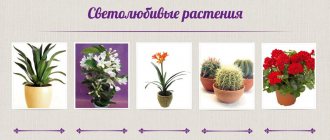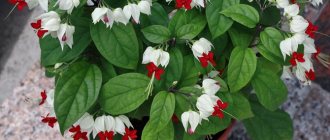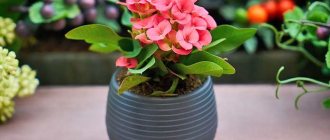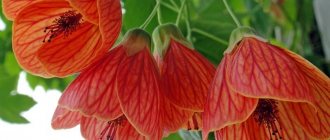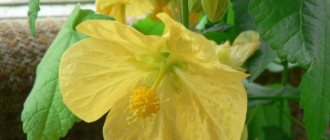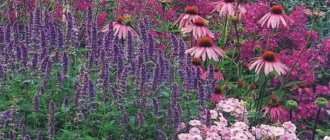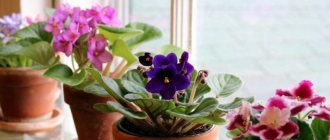Flowers of purple color with various shades represent mysterious, secret and mystical cosmic energy. It’s not for nothing that they attract so much attention and give peace, tranquility, good mood and happiness. Many gardeners like to grow purple flowers both for indoor decoration and for creating landscape design in their garden. Let's take a closer look at indoor and garden flowers.
Names of purple indoor flowers
The purple color of the petals looks advantageous in a classic or minimalist interior; such plants always attract attention. There are many varieties of domestic crops with light or dark purple buds. And each of them requires proper care and attention. In this case, the flower will delight you with flowers all year round. If you do not provide the plant with comfortable growing conditions, it stops blooming and eventually dies.
Himalayan geranium. The shrub plant reaches only 30-60 cm in height. It is distinguished from other species by large flowers with lilac petals of varying degrees of brightness (from light lilac to rich, with pinkish veins).
Standard care:
- moderate air temperature (tolerates both heat and coolness, but only for a short time);
- diffuse lighting;
- draft protection;
- watering 2-3 times a week, depending on the time of year.
Achimenes Ehrenberg. Reaches half a meter in height. It has straight and thin stems on which grow medium-sized leaves with a bright green color and clearly visible veins. The flowers are purple at the edges and deep lilac closer to the center. The flowering period occurs from the beginning of spring to the end of autumn.
Saintpaulia. There are many varieties of the plant. They all differ from each other in the color of their buds. They are terry or glossy, light lilac or bright purple. Plants with a heterogeneous shade that combines several colors at once (duochrome, chimera, bordered) look unusual. Saintpaulia grows up to 30 cm in height, has thin stems and a shallow root system. Roots well in loose soil mixed with sand.
Gloxinia. The plant has a tuberous root system, thin stems surrounded by double green leaves. Buds with a diameter of 5 cm bloom at the tops of the stems. They are distinguished by their border color - white at the edges and dark lilac in the center. The shape of the petals is wavy, heterogeneous. Flowering occurs in the summer and lasts 2-3 months.
Calla purple. It has the same structure of stem, leaves and flowers as the classic white variety. A distinctive feature of the plant is the deep purple hue of its petals. The color is uniform, inclusions of other colors are rare, which depends on the type of crop.
Passionflower. An exotic plant, notable for its unusual flower shape. The petals are painted in different shades of lilac. In one inflorescence there are light and rich tones. In the middle there is a corolla, which consists of bright purple threads, and a yellow anther. The leaves have a complex shape with jagged edges. The stem is thin, growing upright.
Stapelia shaggy. The plant belongs to the category of succulents. It has strong and fleshy leaves, thick stems in which moisture accumulates. Buds form at the tops of the stems, which then bloom into bright purple, star-shaped flowers. The flower is double, covered with barely visible fibers. Some varieties have light veins on the petals.
Streptocarpus. Dark terry leaves of a green hue are collected in a basal rosette. Stems rise from it to a height of 20-30 cm, and on their tops purple, funnel-shaped flowers with white veins and a light center are formed. The buds reach 5-7 cm in diameter.
Fuchsia. An evergreen exotic plant with thin green branches-stems on which bright purple flowers of unusual shape bloom. They have a corolla-shaped cup and a tube-shaped corolla. The surface of the petals is terry or simple. The flower is easy to care for, but in winter it needs rest.
Under the wrong conditions, the flowers first change color, become dull, and become covered with spots. The emergence of such a situation indicates that it is necessary to reconsider the care of the crop.
Purple leaves in potted crops
Such plants are grown to decorate the interior, saturate the air with oxygen and for aesthetic pleasure. Flowers with purple leaves (photos and names) represent the following species:
Ginura
It has lilac, deep purple and burgundy carved leaves, and there are purple hairs on the wavy blades. Loves bright lighting and is easy to care for. It should be planted in soil with neutral acidity, loosen it occasionally. Soil composition: leaf and turf soil, coarse river sand. Temperature in summer is 20-24° Celsius, in winter – up to 13°. If kept in a warm room in winter, then you need to extend the daylight hours with additional lighting with lamps. During active growth, feed 2 times a month. To create a decorative bush, Ginura is regularly pinched to make it branch better. Rejuvenation: cutting of apical cuttings and their rooting is carried out every 2 years.
Zebrina
An unpretentious indoor plant with striped leaf blades: silver-green and purple. It should be placed on well-lit window sills to maintain a rich color scheme; in the shade the leaves will turn pale green. But the plant must be protected from direct sunlight. Feed every 2-3 weeks in April-September, water moderately, plant in soil mixture, as for Ginura. After a year, the bushes are rejuvenated by cutting off the tops and rooted in a pot or placed in water to obtain roots. Do not overfill the plant with water, as the leaves may dry out.
What house plants have this leaf color?
Gardeners also prefer to grow plants that have unusual lilac or purple leaves. There are many varieties of such flowers. They fit well into the design of the house and are considered original due to their appearance.
Hemigraphis. An evergreen plant with lilac foliage. At home, 4 varieties of hemigraphis are grown from a wide variety of species:
- Widely pitted. Reaches 20 cm in height; root nodes are placed on thin creeping stems, thanks to which the plant easily takes root in nearby areas of soil. The lanceolate leaves are purple with a hint of green above and red-purple below.
- Alternate. Brown stems-shoots spread along the ground, their nodes take root in the soil, giving life to new shoots. The leaves are heart-shaped, brownish-purple.
- Color. Curly greenish shoots, wrinkled leaves on top are painted in a violet-blue hue with an admixture of silver.
- Exotic. Thin stems firmly cling to support, so this variety is suitable for decorating various surfaces. The small leaves above are lilac-colored with green splashes, and below they are reddish.
Ginura. Lush fast-growing shrub with small lilac leaves. The stems are creeping or upright (depending on the variety), grow 50 cm in length, hollow inside. The leaves are colored deep purple at the bottom and have bright green veins on top. They are covered with light fluff, giving them a spectacular terry surface.
Zebrina. The leaves of the plant are pointed, they are bright purple below, covered with light whitish stripes above. Hence the name of the flower. Depending on the variety, the stems droop or grow upward.
Irezine. An exotic crop belonging to the amaranth family. This herbaceous, shrub or semi-shrub plant is unpretentious in care, so many of its species take their place of honor in the homes of flower growers.
The following varieties are considered popular:
- Herbst;
- Purple Lady;
- Linden.
Oxalis. An annual or perennial plant with small compound leaves that are curved on the outside. Their distinctive feature is a red-violet hue. The leaf rosettes are shaped like feathers or paws. The culture grows quickly and takes root in moderate conditions and with minimal care.
Reo multi-colored. A distinctive feature is the shape of matte, durable leaves. They resemble triangles connected at the tops. The color of the foliage above is rich green, below is bright purple.
With improper care or improper maintenance conditions, the color of the leaves gradually changes. If you notice this situation, try to reconsider your care and water the plant more often.
Spring bloom
There are very early flowers that delight us before the grass even appears. What is noteworthy is that they are very unpretentious and require almost no maintenance. Well-known spring flowers for the garden are daffodils and tulips. They are very diverse and beautiful, but there are many others that are no less interesting.
Spring flowers - traditional and not so
Snowdrops
These small bulbous plants bloom with delicate white flowers and are known to everyone. The correct name is Galanthus nivalis. They appear immediately after the snow melts, bloom in just a couple of weeks, but the flowering is very short-lived. After the end of the flowering season, the above-ground part dies off. It is recommended to plant near shrubs and trees.
There are about two dozen varieties in total, here are the most interesting and popular:
- Viridapisis. A taller variety. Blooms in February-March. The leaves are grayish-green, flat. Their length is about 10 cm. The flower is white, drooping, 1-3 cm long. There are green spots on the edges of the inner petals.
- Lutescens. It differs in that the inner petals have yellow spots. This variety of snowdrops is capricious - not all soils are suitable for it.
Snowdrops are the earliest flowers for the garden - Pusi Green Type, Ophelia, Flore Pleno - varieties with double snow-white flowers.
- Snow-white or snowy. Low-growing variety - 10-15 cm high with miniature flowers.
- Elvis. Tall - height 15-25 cm, oblong and wider leaves have a bluish tint. The flower is more spherical. Of all the varieties, it is the earliest - in the southern regions it blooms in February.
There are also blue snowdrops. This is another type of flower - Scilla (scilla), but more often they are called Scilla. They are more fragile in appearance and bloom a little later - in April. They tolerate winter well, are unpretentious, and can grow on heavy fertilized soils. In order for them to bloom in the spring, you need to feed them with nitrophoska. Common varieties:
- Siberian scilla. The leaves are basal, wide, bright green. Produces tall peduncles 10-12 cm high, on which there are from 1 to 5 blue-blue drooping flowers. Early flowering - 10-15 days after the snow melts. There is a white subspecies with later flowering.
Another type of snowdrop, Scylla, blooms blue - Spring Beauty. It produces powerful violet-green arrows, on which are placed 5-6 large flowers with a diameter of about 3 cm. The color of the flowers is dark purple. Reproduces by children.
There are even rarer varieties, but they are difficult to find, and they are more capricious when growing. The combination of white and blue snowdrops looks very attractive.
Crocuses
Another bulbous flowers. They bloom in the same period as snowdrops, have similar sizes, but the color is more varied - there are white, yellow, purple, lilac. For greater effect, it is better to plant in groups, mixing colors. You can plant it anywhere - under trees and shrubs, in the open. They are sun-loving, but can also tolerate shade and winter normally under snow. You can plant it in the ground, you can plant it in containers.
There are quite a few varieties that differ in flowering time, plant height and color intensity:
- Two-flowered crocus (Crocus biflorus). It has a very interesting color. There are white, white with purple stripes on the outside of the petals, white inside, with lilac-blue spots on the outside of the petals, with purple-brown stripes. The throat of this crocus species is white or yellow.
- Spring crocus (Crocus vernus). A large plant up to 17 cm high. The tuber is flattened and covered with scales. The leaves are narrow, long with a silvery-white stripe in the middle. The flowers are white or purple, bell-shaped, elongated. One or two flowers can grow from one tuber. Flowering time - late April, early May, flowering period - about 3 weeks.
Spring flowers for the garden - different types of crocuses - Golden crocus (Crocus chrysanthus). Tall variety - up to 20 cm in height. The leaves are narrow and long, the flowers are golden yellow in color, and may have brown stripes or markings on the outer part of the petals. Styles are red, anthers are orange. They bloom in April for 3 weeks.
- Crocus Tommasini (Crocus tommasinianus). Low-growing variety - up to 6 cm tall. One bulb can produce up to 3 flowers. The color is pinkish-lilac, with a white border along the edge. The open flower looks like a star with a white center and a white anther. It blooms in April, the flowering period is up to 3 weeks.
Crocuses in a flowerbed or lawn look very bright and delicate. They are excellent for planting on stones, in free-standing small flower beds, and ridges. After the end of the flowering period, the above-ground part dies off. These primroses are excellent flowers for the garden, which will delight you when there is no grass yet.
Muscari
A moisture-loving and sun-loving perennial plant that winters well in the ground. Propagated by bulbs, usually blooms in April-May. The foliage is rich green, the inflorescences are multi-flowered, blue, purple, sometimes blue and white. Here are the most popular varieties:
- Mukari Armenian (Colchian). A winter-hardy variety that blooms in May. The inflorescence has an interesting color - the top is white, the lower flowers are bright blue, with a white border along the edge.
- Muscari grape-shaped. Another winter-hardy variety that overwinters in the ground. It has smaller flowers than the Armenian one, the color is blue, the height of the peduncle is up to 20 cm, the inflorescence itself is 2-3 cm, in which 15-35 small flowers are collected. There are garden varieties - album with white flowers and a flowering period a week later, carneum - pink.
Muscari are perennial bulbous flowers that bloom in spring. - Muscari latifolia. It has wider and denser leaves, similar to tulip leaves, the inflorescence is denser and more cylindrical in shape. The flowers are dark blue; one bulb can produce several peduncles.
- Muscari crested. Original flower. In nature, the top of the inflorescence is decorated with long thin outgrowths - a pappus (pictured in the center). The hybrids developed are completely shaggy and lilac in color.
There are very cute and original varieties of muscari - Terry muscari. These are hybrid varieties, a week or two later than those listed above, the flowering period is 4 weeks, longer in cool weather. Flowers - double, inflorescences - 5-6 cm. Color - blue, blue, white, lilac.
Muscari are unpretentious spring flowers that require almost no care. Good in rock gardens, ridges, in individual flowerpots and flower beds. They reproduce by bulbs, the young plant blooms in the third year. It needs to be replanted every 5-7 years. In general, if you need unpretentious flowers for your garden with an early flowering period, this is muscari.
Vesennik or Erantis (Eranthis)
Another unpretentious flower for the garden is Vesennik. A perennial herbaceous plant that blooms in early spring with tuberous thickenings in the roots. The flowers are bright yellow or white, cup-shaped, peduncles up to 25 cm high, leaves are rich green, palmate. There are 7 species, most often you can see in flower beds and plantings:
- Winter erantis (Eranthishyemalis). Flowering is very early - groups of flowers appear right from under the snow - 5-6 pieces each, leaves grow later. Leafless peduncles 15-20 cm long, at the ends of which there are bright yellow cup-shaped flowers. Immediately below the calyx of the flower there is a bract of green dissected leaves. Against the background of snow or black earth they look very bright and cheerful.
Spring flowers for the garden - unpretentious, overwintering in open ground - Siberian springweed (Shibateranthis sibirica). There are few leaves - there may be only one basal leaf. The flowers are bright yellow, surrounded by bright green bracts. Blooms in May.
- Eranthis longistipitata Regel. Similar to Winter Vesennik, but taller, produces single peduncles.
- Eranthisstellata. It blooms in April, in nature it grows in the shade of cedar trees and on the edges of well-moistened places. The flowers are white on a high leafless peduncle, basal leaves - 3-5 pieces.
Looks decorative when planted in a ridge, on stones - Cilician Eranthiscilicica. The least frost-resistant variety, as it is of southern origin - Greece and Asia Minor. The flowering period is 2 weeks later than winter Erantis. Low ten-centimeter peduncles with finely cut leaves are crowned with large flowers of a deep yellow hue.
Spring flowers are light-loving flowers for the garden. It is better to place them in high, well-lit places where the snow melts first. They prefer light, well-moistened soils with an alkaline reaction.
They reproduce mainly by seeds, since few tubers are formed. The seeds ripen by autumn and are immediately sown in the ground in a shady place. When sowing in spring, stratification is necessary - 2 weeks at 1-2 °C. In the first year, only cotyledon leaves grow, which quickly die. The plant itself lives, having managed to form small nodules. In the second year, one true leaf grows. In the fall of this year, you can dig up the nodules and plant them in a permanent place. The following year Vesennik blooms.
More popular perennials that bloom in spring
There are a lot of beautiful and unpretentious flowers for the garden that bloom in spring. A detailed description listing the most popular varieties will take dozens of pages. To give at least a general idea, we list them, indicating the timing of flowering, height, and planting characteristics, if any (photos are required).
- Periwinkle. This is a low-growing creeping subshrub with erect shoots. The leaves are dark or light green, leathery, some varieties have white or pink edges. The flowers are large and solitary. The color is usually blue, but there is white and pink, soft lilac. Blooms massively in spring, with single flowers throughout the growing season. Prefers well-drained, loose, fertile soils with a neutral or slightly acidic reaction. A shade-loving plant that does well in partial shade.
Periwinkle is not just creeping plants - Forget-me-not. Height - 10-50 cm, foliage is rich green, small, numerous flowers of blue, dark blue, sometimes pink flowers are collected in inflorescences. It is grown for two years; in the third year the stems become much longer and the flowers become smaller. Loves shady, humid places, blooms from the end of April, up to 3 weeks. Goes well with daisies, tulips, pansies, daffodils.
The cute charm of forget-me-nots will decorate the flowerbed - Anemones (Anemone). Numerous species with different flowering periods - from spring to autumn. Beautiful cup-shaped flowers with different numbers of petals, different colors - white, blue, indigo, lilac, lilac, pink, red, orange. The number of petals varies - from five in the “simple” to terry. Cold-resistant flowers, but it is better to mulch for the winter.
Anemones - a huge number of colors, shapes - Primroses. Most are perennials, but there are biennial and annual herbaceous plants. They bloom in early spring; with the onset of heat, the above-ground part dies off. The leaves are whole, wrinkled, collected in a basal rosette. The flowers are regular in shape, five-petaled. They can be solitary or collected in inflorescences (racemose and umbellate). The colors are varied. It's hard to even describe. Dimensions - from 10 cm (Primula veris and Primula japonica) to 60 cm (Primula obconica). Prefer partial shade with good ventilation.
Primroses are very numerous. There are very, very many shapes, types, colors
These are not all perennial flowers for the garden that bloom in spring. There are hundreds more. But these are loved by gardeners for their unpretentiousness, long flowering period, bright colors and variety of shapes.
What are the features of cultivation and care?
Any indoor culture needs to create optimal conditions for normal growth and development. Care consists of the correct choice of substrate (soil), watering, fertilizing, creating suitable air temperature and lighting:
- Priming. Houseplants have a shallow root system, fine roots that require loose soil to grow. Therefore, ordinary soil is mixed with sand and charcoal. And for drainage they use pumice and expanded clay. These elements allow water to better penetrate the ground, from where moisture enters the roots and body of the plant.
- Pot. You need to choose the right container for growing. You need a spacious, but not very deep pot so that the roots are not crowded in it. It is recommended to give preference to ceramic and plastic options. Such containers heat up less in the sun (overheating leads to fungal infection of the roots and their rotting).
- Light. Lighting should be moderate; bright flowers do not tolerate direct, burning rays of the sun. Such crops need to be placed in slightly shaded areas. Plants develop at room temperature, but are able to survive in cool or hot conditions, but only for a short period.
How to water and fertilize?
Watering and fertilizing are mandatory procedures in caring for indoor flowers. It is recommended to water the plants early in the morning or after sunset (in extreme heat and sunlight, moisture evaporates faster from the soil and does not have time to be absorbed into the roots). When watering, you need to pay attention to the surrounding conditions: the higher the air temperature, the more abundant the moisture should be. This means that in spring and summer, purple flowers are moistened 2-3 times a week; in winter, it is recommended to reduce watering.
The soil is fertilized in the spring, when the roots and other parts of the plant are in a state of active growth. During this period, nutrients are more readily absorbed by the crop, and accordingly, the procedure gives better results. If necessary, for example, if poor soil is used, it is recommended to repeat fertilizing in the fall.
Important! The type of product is chosen depending on the plant variety. Most often, nitrogenous compounds or silicates are used. They are diluted with water in the ratio indicated on the package and poured into the soil, being careful not to touch the roots.
Transfer
It is recommended to replant indoor plants in early spring, when all life processes are activated after winter dormancy. It is necessary to carefully remove the flower from the pot without touching its roots. Drainage is placed in the container for transplantation and a little soil is poured. Place the plant there, sprinkle it with substrate, and moisten it abundantly.
Carefully! It is not recommended to fertilize immediately after transplantation. The plant needs time to take root in its new growing location.
It is better to fertilize and prune crops 2-3 weeks after they are moved to a new pot. This procedure must be carried out as the plant grows, since some varieties require frequent replanting, others - once every 2-3 years.
Diseases and pests
Often, a houseplant begins to turn yellow, turn black, and its leaves become covered with spots and wormholes. The reason for this is diseases and attacks by insect pests.
Diseases are divided into viral and bacterial. The most common viral pathologies of domestic plants include mosaic and plant jaundice. The first disease, if treated in a timely manner, does not cause serious harm, but worsens the appearance of the crop, as it is accompanied by the appearance of yellow spots on the leaves. Jaundice is considered a more dangerous pathology, as it leads to rapid withering and death of the flower.
Bacterial diseases include:
- Rot (often forms on dense, fleshy leaves). The main reasons are increased air humidity and abundant use of nitrogenous fertilizers.
- Withering. With proper care, the plant begins to turn yellow and wither, which means it is affected by pathogenic bacteria.
- Dark and yellow spots. Unlike mosaics, they have a clear outline, which indicates bacterial damage.
- Bacterial cancer. Durable growths appear on the stems and shoots, which interfere with normal metabolism. As a result, the plant gradually dies.
Indoor flowers are also susceptible to pests, such as:
- spider or soft-bodied mite;
- aphid;
- scale insect;
- thrips;
- whitefly;
- felt
Important! If symptoms of the disease are detected, the affected parts of the plant must be removed immediately before the disease spreads to healthy areas.
The plant must be treated with an insecticide; if necessary, repeat this procedure after 14 days until all symptoms disappear completely.
Shades of purple in landscape design
Purple is considered a “cool” color and includes many shades. Some of them have their own name associated with a natural standard, for example, light purple is lilac, violet is deep purple, lilac is pale shades of dark purple, bright and rich purple is lavender. Magenta (magenta) is sometimes considered a shade of violet, although it is made by mixing red and violet (blue).
When choosing a place for such flowers, you need to take into account that in the bright sun the color gradually fades and fades, so it is good if the area is a little shaded at midday. In the shade you won’t have to count on bright colors, but the “neighbors” will save the situation - plants with light or silver leaves, decorative filling in light colors.
Recommendations for using purple flowers:
- cool colors look great both in monochrome combinations and in contrasting ones when white, yellow, cream, apricot colors are added;
- creating a bright accent against a background of light colors;
- a variety of shades gives volume to the space, visually distances the object (for example, a path decorated with lavender or catnip seems longer);
- a composition with white, cream, silver flowers will give the flower garden lightness and airiness;
- Based on purple perennials, you can create compositions in different colors every year.
Related article:
Sizirynchium: types and description
Description of the reproduction process with photos
Indoor flowers reproduce well at home. Most often, in order to grow a new plant, it is necessary to take a viable shoot of the mother crop, properly process it and plant it in the ground.
To do this, you need to choose a cutting that is not damaged. It is cut with a sharp knife at an angle. The cut site is treated with crushed charcoal. The shoot is then placed in a substrate (for example, water) until strong roots are formed on the cut. After this, it is planted in nutritious, pre-moistened soil and watered.
Important! For propagation, shoots are selected that have several buds, from which leaves will subsequently develop.
Every house plant requires a lot of attention and care. And only under such conditions will it actively grow, develop, and delight the owner with large and bright flowers of all shades of purple.
Rate this post

